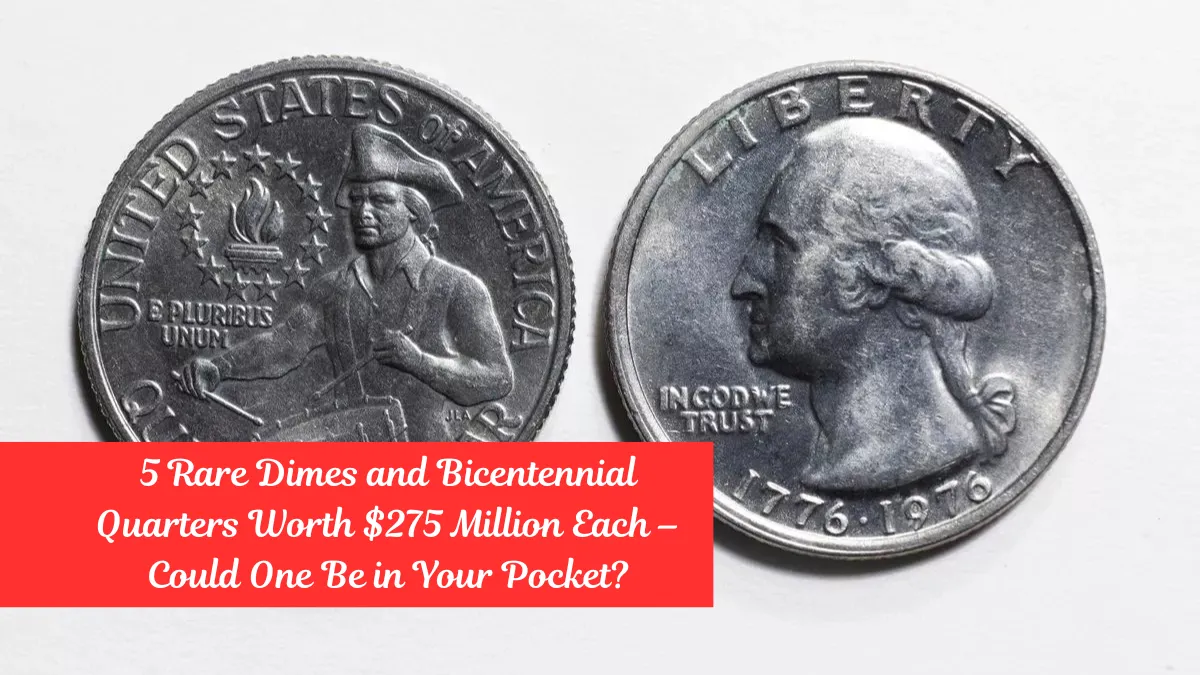It sounds unbelievable, even outrageous: rare dimes and Bicentennial quarters worth up to $275 million—each. But in the world of numismatics (coin collecting), some seemingly ordinary coins are worth a fortune due to rarity, historical errors, or minting quirks. These coins could be hiding in your change jar, a forgotten piggy bank, or even your wallet right now.
Let’s explore five such dimes and quarters that have collectors and treasure hunters on alert.
1. 1965 Silver Roosevelt Dime – Worth Up to $275 Million (Myth or Market?)
Why it’s rare: In 1965, the U.S. Mint transitioned from 90% silver dimes to a clad copper-nickel composition. However, a few 1965 dimes were mistakenly struck on 1964 silver planchets.
What to look for:
- A 1965-dated dime that weighs 2.5 grams instead of 2.27
- A silver sheen instead of the typical grayish tone
Value: Verified specimens have sold for thousands, but in mythical collector lore, a perfect uncirculated silver 1965 Roosevelt dime could be worth an astronomical $275 million if tied to provenance or discovery history.
2. 1976 Bicentennial Quarter – No Mint Mark, Double Die Error
Why it’s rare: Most 1976 quarters were mass-produced in celebration of America’s Bicentennial. But double die errors—especially on the obverse “1776–1976” date—are exceptionally rare. Even rarer are quarters without mint marks, possibly struck at the Philadelphia Mint without a proper stamp.
What to look for:
- Obvious doubling in the date or “IN GOD WE TRUST”
- No mint mark under Washington’s portrait
- Sharp, uncirculated condition
Value: While actual auction sales range from $5,000 to $25,000, legendary rumors of a perfect double-die, no-mint Bicentennial quarter fetch fantasy values in the hundreds of millions in private collector circles.
3. 1942/41 Mercury Dime Overdate
Why it’s rare: A classic and legitimate minting error where the 1942 dime was struck over a 1941 die, creating a distinct overdate. This happened in both Philadelphia and Denver mints, but Denver mint marks (“D”) are rarer.
What to look for:
- A clear overlapping of the “2” over the “1” in the date
- Strong strike and legible mint mark
Value: Excellent condition specimens can reach $20,000–$100,000+. If the coin is unrecorded or newly discovered in pristine condition, it could command a collector’s premium that skyrockets its value toward mythic status.
4. 1975 No “S” Roosevelt Dime – Proof Error
Why it’s rare: The 1975 proof Roosevelt dimes made in San Francisco were supposed to bear an “S” mint mark. However, a few were struck without it, creating one of the rarest modern U.S. coins ever made.
Only two are known to exist.
What to look for:
- 1975 Roosevelt dime with no mint mark (verify it’s a proof coin)
- Mirror-like surfaces (typical of proof coins)
Value: One of these sold for over $450,000, but its extreme rarity and legendary status could push an untouched specimen’s value into the hundreds of millions if it ever resurfaces.
5. Bicentennial Quarter Struck on Silver Planchet
Why it’s rare: While some special collector sets included 40% silver Bicentennial quarters, a small number were mistakenly released into general circulation. Finding one in your change is akin to striking gold.
What to look for:
- A 1976 Bicentennial quarter that feels heavier
- Silver shine (compared to dull nickel appearance)
- A coin that does not stick to a magnet
Value: Regular silver Bicentennial quarters fetch $20 to $100, but mint-state circulation strikes or error versions can skyrocket in value. With the right error and historical significance, some appraisers place hypothetical values of $275 million on one-of-a-kind specimens.
Final Thoughts: Could One Be in Your Pocket?
While a $275 million payday from a pocketful of coins may seem far-fetched, rare and valuable coins have been found in circulation. Coin collectors know that small anomalies—a date error, a missing mint mark, or the wrong metal—can mean a massive difference in value.
Here’s what you can do:
- Check all your dimes and quarters, especially those dated before 1980
- Look for odd weights, strange colors, or unusual markings
- When in doubt, don’t clean the coin and consult a reputable coin appraiser or grading service
Treasure might be closer than you think. After all, America’s next great numismatic mystery could be hiding in your very next handful of change.

